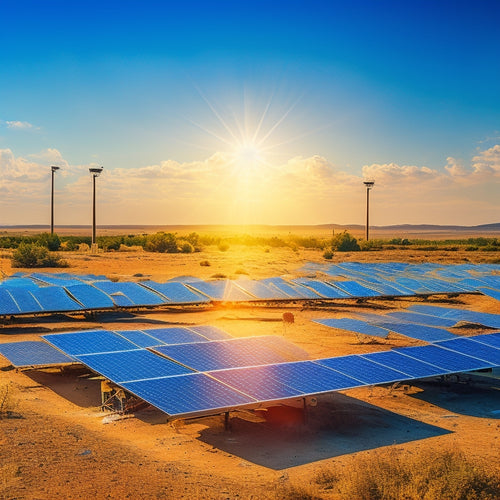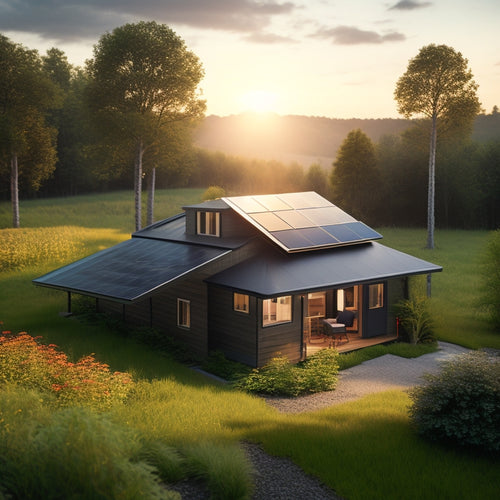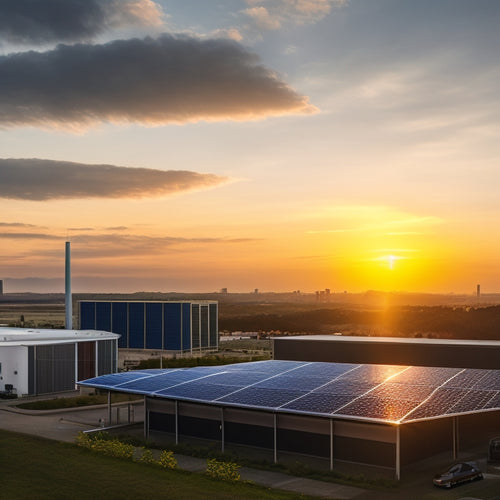
Home Solar Panel Installation Cost
Share
When considering a home solar panel installation, you'll likely pay between $15,000 and $30,000 or more, depending on system size, panel quality, and local installation costs. However, you'll reap significant economic benefits, including reduced energy bills and increased property value. You'll also contribute to environmental sustainability by minimizing your reliance on fossil fuels and offsetting up to 3 tons of CO2 emissions annually. To guarantee a successful installation, it's essential to assess your roof size and configuration, as well as local installation costs. Now, you're one step closer to utilizing the full potential of solar energy - and there's more to investigate.
The Essentials
- The cost of home solar panel installation can be offset by government incentives, covering up to 30% of the total cost.
- Solar panels can save homeowners up to 50% on their energy bills, leading to significant long-term savings.
- The size of the solar panel system, electricity usage, and local rates affect the overall installation cost and potential savings.
- A typical residential solar panel system requires 300-400 square feet of roof space, and roof orientation impacts installation cost and efficiency.
- The installation cost of solar panels varies depending on factors like roof size, complexity, and customized design requirements.
Reduce Carbon Footprint Fast
You're taking an important step towards reducing your carbon footprint by considering solar panel installation.
By switching to a renewable energy source, you'll greatly lower your reliance on fossil fuels and minimize your impact on the environment.
With the rising energy costs addressing energy efficiency being a major concern, utilizing renewable energy is a vital step towards a sustainable future.
Additionally, solar energy caters to individuals looking to increase their energy independence and reliance, providing power even during grid outages.
With solar energy, you're fundamentally going green today, embracing an eco-friendly energy source that's clean, sustainable, and better for the planet.
Go Green Today
Switch to renewable energy sources and break free from fossil fuels by going green today. You can greatly reduce your carbon footprint and contribute to a sustainable lifestyle by adopting renewable resources. The benefits of going green are numerous, and the advantages of solar power are undeniable.
| Benefits | Description | Impact |
|---|---|---|
| Reduced Energy Bills | Lower your energy expenses by generating your own electricity | Save up to 50% on your energy bills |
| Increased Property Value | Enhance your property's value with a clean energy system | Increase your property's value by up to 17% |
| Government Incentives | Take advantage of tax credits and rebates for going green | Receive up to 30% of your installation cost back |
| Reduced Carbon Emissions | Contribute to a cleaner environment by reducing your carbon footprint | Offset up to 3 tons of CO2 emissions per year |
| Energy Independence | Break free from fossil fuels and enjoy energy independence | Reduce your reliance on the grid by up to 90% |
Eco-Friendly Energy Source
By choosing solar power, you're taking an important step towards reducing your carbon footprint. As an eco-friendly energy source, solar panels offer numerous benefits that align with your goal of achieving freedom from fossil fuels.
Renewable energy generated from solar panels reduces your reliance on non-renewable energy sources, ultimately decreasing your carbon footprint. In addition, our innovative products can help you enjoy increased energy independence and greatly lower your energy expenses, all while investing in a brighter future.
With the latest advancements in solar power technology, you can utilize the power of the sun more efficiently than ever before. Solar panel benefits extend beyond environmental advantages. They also provide economic benefits, such as reducing your electricity bills and increasing your property value.
Furthermore, solar panels are relatively low maintenance and can last for up to 30 years or more.
As you shift to an eco-friendly energy source, you're not only reducing your carbon footprint but also contributing to a cleaner, healthier environment. By utilizing the power of renewable energy, you're taking an important step towards a sustainable future.
With solar panels, you can enjoy the freedom of generating your own clean energy while reducing your impact on the environment.
Save Money on Electricity
By installing solar panels on your home, you'll considerably lower your electricity bills, as you'll be generating your own clean energy from renewable energy systems and reducing your carbon footprint.
This eco-friendly approach won't only benefit the environment but also reduce your energy dependence on the grid. This will reduce your reliance on the grid, saving you money on your monthly utility costs.
Additionally, you'll reduce your energy dependence, which can lead to even more savings over time.
Lower Electricity Bills
As you generate your own electricity with home solar panels, you'll markedly reduce your reliance on the grid, and subsequently, your electricity bills will plummet. This reduction in electricity costs is a significant benefit of installing solar panels on your home.
| Electricity Reduction | Solar Savings |
|---|---|
| 50% reduction in electricity consumption | $500 annual savings |
| 75% reduction in electricity consumption | $1,000 annual savings |
| 90% reduction in electricity consumption | $1,500 annual savings |
The amount of savings you'll enjoy depends on several factors, including the size of your solar panel system, your current electricity usage, and the local electricity rates. However, with a significant reduction in your electricity bills, you'll be able to allocate your hard-earned money to more important things. By utilizing the power of the sun, you'll not only reduce your electricity reduction but also contribute to a cleaner environment.
Reduce Energy Dependence
Your energy independence starts with a solar panel system, which enables you to capture the sun's energy and reduce your reliance on the grid. By generating your own electricity, you'll decrease your energy dependence and enjoy the freedom that comes with it.
With solar panels, you'll be less susceptible to rising electricity rates and grid outages, giving you more control over your energy usage.
Moreover, the government offers solar incentives to encourage homeowners like you to shift to renewable energy. These incentives can greatly reduce the cost of installing a solar panel system, making energy independence more accessible than ever.
Maximum Power Point Tracking
You'll want to optimize your solar panel efficiency through Maximum Power Point Tracking (MPPT), which guarantees you're generating the most power from your system.
MPPT achieves this by identifying the ideal voltage and current combination, allowing your panels to operate at their maximum potential.
By employing advanced energy harvesting techniques, such as those used in off-grid systems, MPPT technology can greatly enhance your overall energy production.
This is particularly important when paired with renewable energy storage batteries, as it allows you to maximize your energy storage and reduce your reliance on utility bills.
Panel Efficiency Optimization
Optimizing panel efficiency is vital to maximize energy production from your solar panel installation. You want to guarantee that your system operates at its best to generate the most electricity possible. One important aspect of panel efficiency optimization is Maximum Power Point Tracking (MPPT). MPPT is a technique that allows your solar inverter to maximize the energy output from your panels.
To achieve ideal panel efficiency, you need to take into account the following factors:
| Factor | Description |
|---|---|
| Panel Orientation | Proper panel orientation is essential to maximize energy production. Ideal orientation varies by location and time of year. |
| Shading Analysis | Shading can greatly reduce panel efficiency. Conduct a shading analysis to identify potential obstructions and optimize panel placement. |
| Temperature Coefficient | High temperatures can reduce panel efficiency. Confirm your panels are installed in a well-ventilated area to minimize heat buildup. |
Energy Harvesting Techniques
Maximum Power Point Tracking (MPPT) is an essential energy harvesting technique that guarantees your solar inverter extracts the maximum amount of power from your solar panels.
This advanced technology assures that your solar panel system operates at its finest level, even when environmental conditions like temperature and sunlight vary. By continuously monitoring and adjusting the voltage and current output of your solar panels, MPPT maximizes energy production and reduces energy waste.
You'll benefit from MPPT's ability to adapt to changing conditions, such as partial shading or dirt buildup on your panels. This results in increased energy yields and a faster return on your solar investment.
As solar technology advancements continue to emerge, you can expect even more efficient energy harvesting techniques to be integrated into future energy innovations. By incorporating MPPT into your solar panel system, you'll be well-positioned to take advantage of these advancements and enjoy a reliable, sustainable source of energy for years to come.
Assess Roof Size First
You'll need to assess your roof's size and space availability to determine how many solar panels can fit, as this directly impacts the overall system cost.
Considering factors like photovoltaic cells and energy audit can help you make an informed decision.
Renewable energy systems can be customized to meet your specific needs.
Roof shape complexity also plays a role, as irregularly shaped roofs may require more labor and materials to accommodate the panels.
Roof Space Availability
Evaluating your roof's size and space is the first essential step in determining the viability of a home solar panel installation. You need to evaluate whether your roof has enough space to accommodate the required number of solar panels. A typical residential solar panel system requires around 300-400 square feet of roof space.
You'll also need to take into account your roof's orientation, as a south-facing roof receives the most sunlight and is ideal for solar panels. East- and west-facing roofs can also work, but north-facing roofs aren't suitable.
Next, you'll need to conduct a shading analysis to identify any obstructions that could reduce the system's efficiency. Shading from trees, chimneys, or neighboring buildings can considerably impact your solar panel system's performance.
You can use online tools or consult with a solar panel professional to conduct a thorough shading analysis. By evaluating your roof's size and space, you'll be able to determine the best solar panel system size and layout for your home, ensuring you get the most out of your investment.
Roof Shape Complexity
Typically, homeowners with complex roof shapes face unique challenges when it comes to solar panel installation. You may have a roof with multiple levels, skylights, or an unusual roof angle, which can increase the complexity of the installation process. This, in turn, can drive up the cost of installation.
When evaluating your roof's complexity, you'll want to take into account the number of corners, valleys, and vents. Each of these features can impact the installation process, requiring more time and materials to work around them. For instance, a roof with multiple levels may require additional mounting hardware, while a roof with skylights may need specialized flashing to guarantee a watertight seal.
To overcome these installation challenges, you may need to opt for a more customized solar panel system design. This could involve using specialized racking systems or additional structural support to make certain the solar panels are securely fastened to your roof.
Be prepared to discuss your roof's unique features with your solar panel installer to determine the best approach for your specific situation.
Higher Energy Conversion Rate
You'll want to prioritize efficient energy harvesting systems to maximize your solar panel installation's energy conversion rate.
These systems guarantee that more of the sun's energy is converted into usable electricity, resulting in higher returns on your investment.
Efficient Energy Harvesting Systems
Utilizing maximum energy from the sun requires Efficient Energy Harvesting Systems, which boast a higher energy conversion rate. These systems are designed to optimize your solar panel installation, guaranteeing you get the most out of your investment.
By leveraging state-of-the-art solar technology and energy innovation, you can enjoy sustainable solutions that reduce your reliance on the grid. Photovoltaic advancements have made it possible to capture more energy from the sun, and efficient installation techniques guarantee that your system is set up for success.
To maintain peak performance, regular system maintenance is essential. This includes monitoring your system's performance and addressing any issues promptly.
With grid integration, you can feed excess energy back into the grid and offset your energy costs. This means you can enjoy energy independence and reduce your reliance on traditional energy sources.
In residential applications, Efficient Energy Harvesting Systems can provide significant savings and a reduced carbon footprint. By keeping a close eye on your system's performance through monitoring, you can guarantee you're getting the most out of your solar panel installation.
Frequently Asked Questions
Can I Install Solar Panels on a Rented Property?
As a renter, you'll need to obtain installation permissions from your landlord before setting up solar panels, clarifying renter responsibilities and ensuring a mutually beneficial agreement that respects both parties' interests.
Do Solar Panels Work During a Power Outage?
Did you know that 72% of Americans consider solar power essential for energy independence? During a power outage, you'll still generate electricity with solar panels, but without battery storage, you won't be able to use it; however, with efficient solar panel efficiency and a battery system, you'll have power when you need it.
Are Solar Panels Affected by Shade From Trees?
You'll find that solar panels are indeed affected by shade from trees, which reduces their energy output. To minimize the shade impact, consider tree trimming to clear the way for maximum sunlight exposure and optimize your solar panel's performance.
Can I Expand My Solar Panel System Later?
As you chart your course to energy independence, you're wise to contemplate the flexibility of your solar panel system. Fortunately, you can expand your system later, thanks to system compatibility and future scalability, allowing you to adapt to changing energy needs like a sailor adjusting sails to shifting winds.
Are There Any Incentives for Non-Profit Organizations?
You're likely eligible for incentives as a non-profit organization, such as tax credits, which can greatly reduce your upfront costs, and investigate funding options like grants and low-interest loans to support your sustainable efforts.
Final Thoughts
You've made it this far, and now you're ready to utilize the power of the sun. But, are you prepared to invest in a cleaner, more sustainable future? With home solar panel installation, you'll reduce your carbon footprint fast, save money on electricity, and maximize energy conversion rates. So, what's holding you back from taking the first step towards a greener tomorrow?
Related Posts
-

What Happens Without a Charge Controller in Solar Panels
Without a charge controller in your solar panel system, you risk overheating batteries due to overcharging, which can...
-

Diy Off Grid Solar
By embracing DIY off-grid solar, you can break free from grid dependence, slashing your energy bills by up to 90% and...
-

Advantages of Commercial Solar Battery On-Site Storage
By investing in a commercial solar battery on-site storage system, you can greatly reduce your energy grid dependence...


